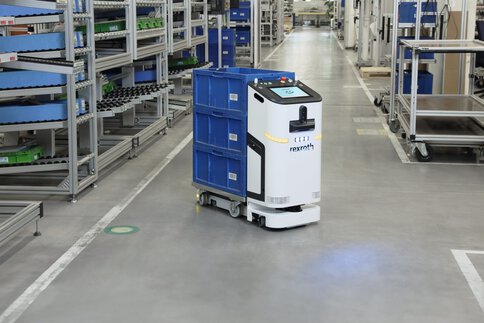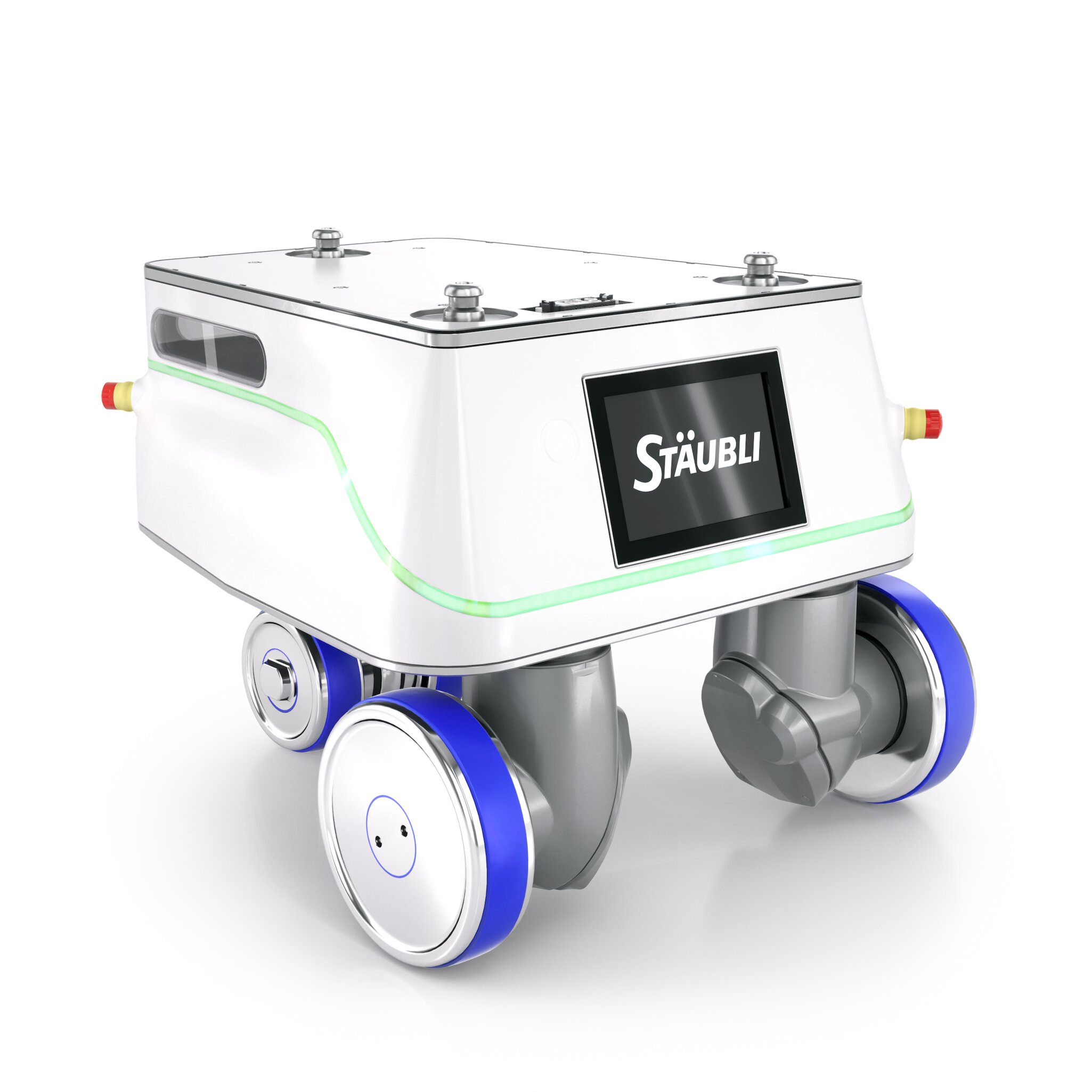Robotics on the move—in Munich
Robots are becoming increasingly agile. In the shape of cobots, an ever-growing number of them joins their human colleagues to support their work. Others are called autonomous mobile robots and independently navigate as they make their way across the factory. These AMRs represent a genuine growth market—and are a focal point for many suppliers at automatica.
From the outside, AMRs are almost identical to AGVs (automated guided vehicles) that have been around for decades. But a closer look reveals fundamental differences. Because: AGVs can be considered the ‘public transport’ of internal material flow. They ply on fixed routes and rely on rudimentary guidance systems. AMRs, however, navigate freely to any desired destination—just like private cars. Thus, they make transport flexible. This capability requires spatial orientation and the ability to recalculate or change routes.
It looks like they are the future of intralogistics—and a real alternative to ‘manned’ material handling equipment. The market for autonomous mobile robots is booming and will see continued long-term growth. According to projections by the Straits Research market research institute, its global volume amounted to around 4.32 billion USD in 2023 and is expected to more than double by 2032 (9.2 billion USD).
Among other factors, this growth is fueled by easier and quicker AMR integration options as compared to AGVs. That makes them more suitable for deployment in smaller companies. And since their navigation does not rely on fixed route markers, they are the perfect choice for temporary or continuously changing use cases—especially since there are special low-cost AMRs now.
Huge variety of providers
Anyone looking to learn about the AMR market at automatica should come prepared: The range of exhibits presented here is quite extensive and, in addition to the established robot manufacturers who have expanded their portfolio by AMRs, includes numerous start-ups. Exhibitors offering AMRs are located in Hall B4, which features a special ‘Mobile Robots in Production: Mesh-Up’ area.
Some examples: Agilox increases the load bearing capacity and, thus, the deployment options of AMRs that tend to transport lighter loads than AGVs. The new Omnidirectional Free Lifter is different: It is capable of lifting pallets and other load carriers weighing up to 800 kg to a height of up to 1,200 mm.
Bosch Rexroth seamlessly integrates conventional automated guided vehicles (AGVs) and AMRs in a common logistics process using the open VDA 5050 interface. This concept also facilitates the inclusion of tractors and other (autonomous) vehicles. With its ‘less is more’ approach, Filics has boiled down pallet transportation to two separate autonomous runners exploiting the characteristic synchronization of movements in AMRs—a genuine innovation.


A powerful combination: AMR plus cobot
Hanwha Robotics is a Korean manufacturer who has integrated its six-axis robots with a mobile platform, thus offering a robotics ‘all-rounder’ capable of taking on a wide variety of handling tasks in assembly or warehousing. Igus offers a successful low-cost AMR of the ReBel Move type—now also supporting deployment in AMR/cobot combinations.
The Danish robotics experts of Kassow claim that the collaborative robots of their KR series have the smallest footprint in the market. Integrators such as the Project Service & Produktion GmbH use these robots as a basis to form AMR/cobot combinations. Its integrated laser scanners enable their compact mobile Orbyn robot to move freely among employees in collaborative mode—and its intuitive programming is a huge advantage.
automatica is a home game for the Munich-based robotics provider Magazino. The company—now part of Jungheinrich—was among the first to provide mobile robots with an additional degree of freedom. Their ‘Soto’ perform tasks such as reaching into a shelf to pick up shoe boxes or books. It can also stock shelves with supplies for assembly workstations used in environments such as truck production facilities.
Mobile robots advance into aseptic environments
Neura Robotics has developed mobile, cognitive, and collaborative robots working ‘hand in hand’ or ‘gripper in gripper’, respectively as they take on both transport and assembly tasks in environments such as automotive production or mechanical engineering. With their GT1 model, Safelog has developed a compact AMR with ‘integrated swarm intelligence’ for pallet transportation.
Stäubli presents a worldwide novelty: The Swiss company’s Sterimove is a mobile platform for an entirely new and highly demanding application area: all types of cleanrooms. The fully encapsulated vehicle is the first one of its kind worldwide to achieve certification for sterile GMP Grade A/B environments. It saw strong demand from the pharmaceutical industry the moment it was introduced.
In addition to these manufacturers, a number of software providers and system integrators will also present their offerings relating to AMR applications—e.g. Idealworks, a BMW spin-off providing complete software suites for AGV and AMR operation. The MHP software and consulting company, part of the Porsche Group, has created FleetExecuter to facilitate the control and coordination of AGV and AMRs of different manufacturers. And all those are just a few of many exhibitors focusing on autonomous mobile robotics in Munich.


Standardization and simplified navigation promote market growth
The current growth in the AGV and AMR market is, to a significant extent, based on standardization—and the VDA 5050 standard is a particularly good example of the associated benefits. While compliance with this standard is not mandatory, it facilitates the integration of vehicles from different manufacturers into various automation environments.
Recent navigation technology such as the much-praised SLAM technology provides an additional ‘push’ to the adoption of mobile robots. Thanks to its ‘Simultaneous Localization and Mapping’ feature, AMRs can now independently record their environment and adapt to existing or even continuously changing conditions—without any permanent infrastructure installations.
Perfect for brownfield automation
It is this characteristic that makes AMRs a perfect solution for automation in brownfield environments, which are much more numerous in practice than new constructions on greenfield sites. Here, AMRs can be implemented and commissioned via a simple ‘drop in’ and ‘teach in’ procedure—and that’s not even a big exaggeration. Successive automation is also possible in this context. These are very popular advantages in the face of steadily rising labor and operating costs due to the continuing lack of specialists. The market data for AMR adoption backs up this claim.
AMR deployment is further advanced through increased AI adoption. It unlocks robot functions such as smarter navigation, route optimization, as well as irregularity detection and reporting as part of preventive maintenance. And soon they will also be able to recognize and complete tasks independently. This is where autonomous robotics is still in its infancy. But this is a different trend that will also be discussed at automatica in great detail.
Text: Ralf Högel on behalf of Messe München
